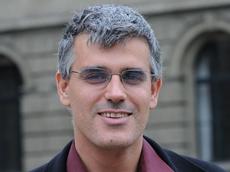Higgs Bosons instead of basketballs
This year's ETH Zurich Latsis Prize is awarded to Charalampos Anastasiou. The Greek physicist almost became a basketball professional. Instead he now plays successfully with the smallest particles.

After one year of an enforced break it now restarts: the Large Hadron Collider (LHC), the particle accelerator at Cern near Geneva. Scientists are full of anticipation to spot the feverishly sought after Higgs Boson, an elementary particle of matter, in the flood of proton collision data.
If this mysterious particle, hitherto existing only in theory, is actually detected, one ETH Zurich researcher will have played a major role: Charalampos Anastasiou, tenure track assistant professor in particle physics. His theoretical considerations and complex calculations predict precisely which of the innumerable collisions will signalize the Higgs boson. For this achievement, the assistant professor receives this year’s ETH Zurich Latsis Prize, which will be awarded to him on ETH Day.
Higgs Boson accurately predicted
In the awards presentation the prize committee remarks that Anastasiou and his collaborators made a vital contribution to particle physics by significantly improving on the predictive power of the theory. During his career he developed several methods to enhance the precision of the theory. While the first method was only capable of calculating the total number of produced Higgs bosons at particle accelerators, it still offered an enormous improvement at the time. In the course of many years he developed more methods which allowed to simulate fine details in the collisions.
“We now have a big chance of finding this particle at the LHC, provided the theory is correct,” Anastasiou thinks. He is confident that the Higgs Boson or something else will be found thereby making one of the biggest discoveries in particle physics. However he adds "if only the Higgs Boson is found but nothing else, this would be the most prosaic of all the possible scenarios". The 35-year-old exceptional scientist says that research is about to unlock a door to a room with music heard from the outside.
“The only thing we don’t know is the tune which is played.” No-one knows exactly what is awaiting us behind this door.
Physics instead of basketball
He had almost opened another door, behind which an entirely different career awaited him. Being tall, he was an enthusiastic basketball player in his youth. This is why he wanted to study sports science. On the morning he needed to push open the stadium doors to enroll for the degree programme, he held back his hand. He reconsidered at the last moment and studied physics in Athens.
After writing his diploma thesis on astrophysics, he turned to particle physics. He obtained his PhD at Durham University (GB). He has held postdoctorial positions at Stanford for three years and at ETH Zurich for two years. After that he worked for one year at Cern. For the last two years, he has been back at ETH Zurich, where he now has a tenure track assistant professorship and a research group.
“Good physics” is the aim
He says his career has not always been easy, although it may appear to have gone smoothly when viewed from the outside. Many things in physics happen spontaneously, but there have been times in which he had to fight his way through. “But for me there was no way back.” The main aim of his work has not been to reach a particular position but to do “good physics”. One of his great pleasures is to pass on knowledge and know-how to others and to make other people enthusiastic about physics.
Today he and his group are working on complex problems, on a bigger vision which, according to Anastasiou, is not feasible without the support of a group. With the younger scientists in the group, who introduce new theories and extend existing ones, he aims to improve theoretical physics. “That has changed the orientation of my work in a positive way,” says the researcher.







READER COMMENTS